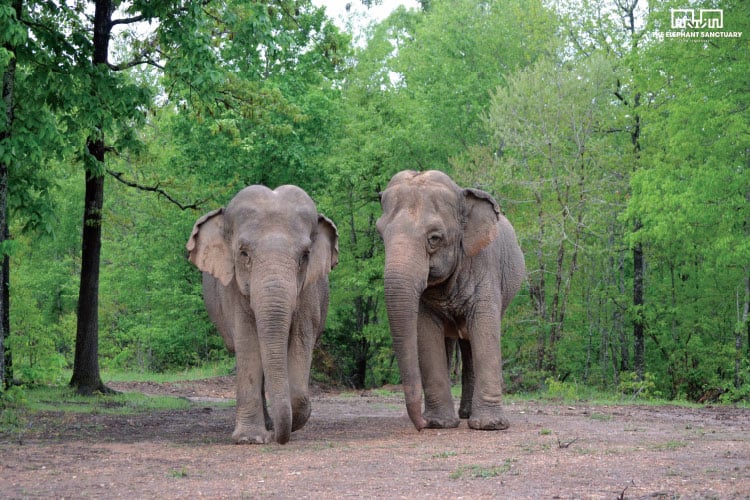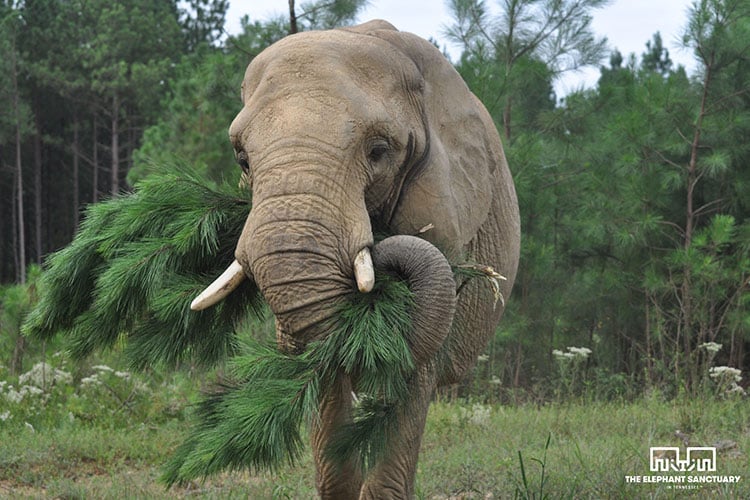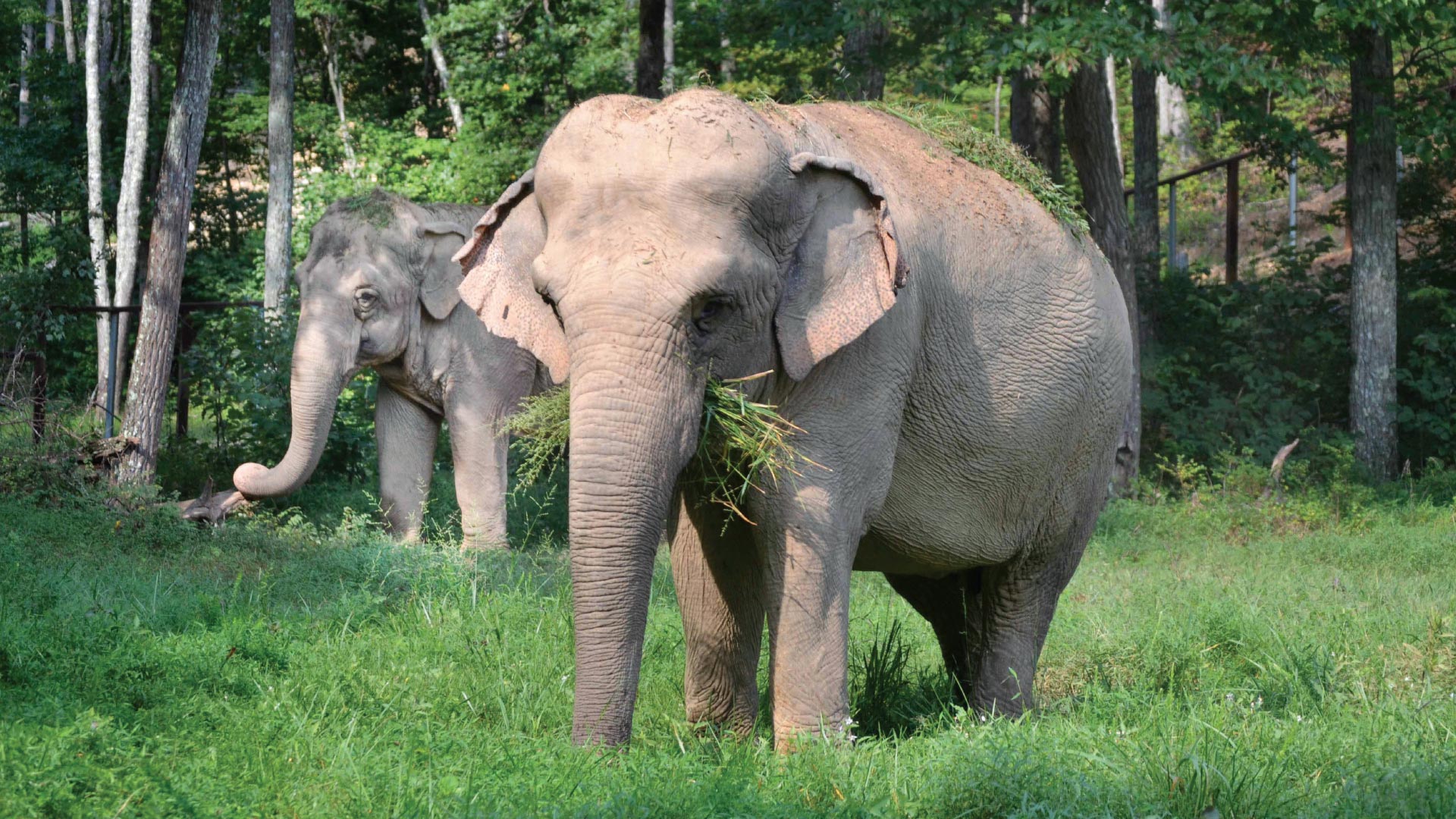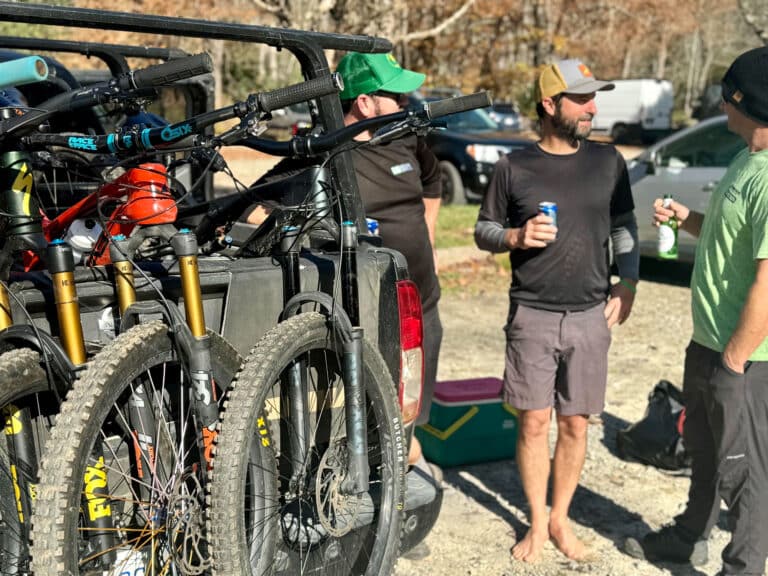How did a farm south of Nashville become the country’s largest elephant sanctuary?
Just before 8 a.m. on a Monday, Shirley stands in the middle of a field, using her trunk to sift through the brush on the ground. Her right hind leg bends out at an awkward, almost 45-degree angle, the lingering result of bone reconstruction after an altercation with another circus elephant over two decades ago. At 70 years old, Shirley walks slowly from a grassy patch to dry ground, swinging her trunk as she surveys the land. She stops at a sand pile, scooping chunks with her trunk and spraying them onto her back, cooling herself on an already-warm May morning.
Though her injuries linger, Shirley is no longer confined to circus life. Instead, she is one of 11 total elephant residents of The Elephant Sanctuary, a home for retired performance and exhibition elephants. One of only two certified elephant sanctuaries in the U.S., the Elephant Sanctuary, located in Hohenwald, Tenn., doesn’t allow visitors; instead, Shirley’s wanderings are observed through the Sanctuary’s popular Elecams, a system of solar-powered cameras used to monitor the elephants and broadcast a live feed via the Sanctuary’s website, which Sanctuary staff also use for educational outreach programs throughout the year.
Founded in 1995 by Carol Buckley and Scott Bais, the then-110-acre Sanctuary adopted its first resident—Tarra, an Asian elephant who, since the age of two, had performed in circuses and acts around the country. In the mid-1990s, after two decades of traveling and living in cramped quarters, Tarra needed land to roam as well as other elephants to interact with. “They also wanted a place where other elephants could retire and form a herd that maybe they hadn’t experienced earlier in life,” Joy Owens, The Sanctuary’s Education Manager, says of Buckley and Bais’s vision.

Buckley and Bais chose to establish the Sanctuary in Hohenwald, Tennessee, a town of four-and-a-half square miles and close to 4,000 people, 85 miles southwest of Nashville. The climate—mild weather, short winters and warm summer temperatures—roughly mirrors a wild elephant habitat, and the duo was able to purchase a wide swath of land at low cost with the hopes of adding more elephants and acreage over time.
The next elephant, a former circus elephant named Barbara, arrived a year later, in 1996. Since that time, 28 elephants—all female—have lived at The Sanctuary, including the 11 current residents who inhabit over 2,700 acres of three separate habitat areas.
The Sanctuary provides a home for the elephants to live in an environment more closely matched to their needs—ample land, ample food, a pseudo-herd and unstructured days. (They also each have their own barn space, complete with heated floors in winter). Typically, captive elephants cannot be re-introduced into the wild; as such, creating a parallel environs aids in their survival—and quality of life.
As threats to elephants throughout Africa and Asia have increased in recent decades, particularly poaching, trophy hunting, and habitat destruction, havens like The Elephant Sanctuary highlight the importance of saving this beautiful mammal, classified as both threatened (African elephant) and endangered (Asian elephant). There are an estimated 400,000 African elephants remaining in the world; the Asian elephant population has decreased to an estimated 40,000 worldwide.
The Elephant Sanctuary and PAWS (Performing Animal Welfare Society) in California, which was founded in 1984 to protect and house formerly captive and performance wildlife animals, are the only two elephant sanctuaries in America accredited by the Global Federation of Animal Sanctuaries (GFAS). These organizations, as well as international non-profits and governmental organizations, are working through a variety of methods to save the species—before it’s too late.

An elephant’s day at The Sanctuary is intentionally unstructured. Elephants spend up to 18 hours a day eating, so the majority of their time is spent wandering, dining, and in some cases, socializing. While Sanctuary caregivers drop food for them, the elephants also walk around and forage independently. In the wild, a female elephant stays with her family herd for her entire life; a baby will often stay with her for up to five years. Male adult elephants, following procreation, are kicked out of the herd to live as a bachelor or with other males.
Unrelated elephants typically won’t live together in the wild; at the Sanctuary, since most of the elephants aren’t related, they are gradually introduced to one another.
When a new elephant arrives, she is kept on her own while the Sanctuary’s full-time staff of 45 workers, including 15 caregivers and four veterinarians, learns her health history and habits. This also allows for the new female to see, hear and smell the other elephants without being forced to share space. If the new and resident elephants are curious about each other and show positive behaviors, they are set up on ‘play dates,’ where they share space together (though African and Asian elephants are not intermingled, given the inherent species differences). If the elephants have a common fence and aren’t getting along, they won’t be introduced to one another.
In 1999, Shirley arrived at The Elephant Sanctuary from a zoo in Louisiana, where she’d been the lone elephant for 22 years. Remarkably, on her first night, she recognized Jenny, an elephant she’d performed with in a circus over two decades prior. From that day onward, the two were almost inseparable, forming a mother-daughter-like bond that continued until Jenny’s passing in 2006.
“They definitely have personalities and behaviors, likes, and dislikes,” Owens says. “Ronnie is the social butterfly, because she’s almost always in the company of another elephant and doesn’t like to be by herself. Flora likes to spend more time alone. A lot of behavior tells us about personalities. The caregivers see them every day and can really observe the minutiae of their behavior.”

The average life expectancy of an elephant in the wild is close to 60 years; in captivity, it is much shorter, as females living in a zoo live an average of only 17 years. “A big reason [for the shorter life expectancy] is that we haven’t been able to replicate the herd very well in captivity, and that’s really crucial to keeping an elephant happy and healthy,” Owens says. 70-year-old Shirley is the oldest elephant at The Sanctuary; at 34, Sukari is currently the youngest.
Elephants sleep the least amount of any land mammal, typically only two hours a day. Otherwise, they are eating (elephants can consume hundreds of pounds of plant matter in one day), wandering, and socializing, behaviors that are limited by captivity, particularly by zoos. Instead, “providing space like The Elephant Sanctuary for elephants to be elephants is definitely the way to go,” Tanya Sanerib, Senior Attorney & International Program Legal Director for The Center for Biological Diversity, says. Elephants are also very intelligent, with the largest brains of any land mammal; enclosures, by and large, bore them.
PAWS houses five African and three Asian bull elephants at ARK 2000 in San Andreas, providing the elephants—along with 22 tigers, 4 lions, 7 bears and 1 black leopard—with 2,300 acres of natural terrain to roam, lakes and pools for bathing, and elephant barns equipped with heated stalls and an indoor therapy pool.
Co-founder Ed Stewart says that PAWS was established in 1984 to “be advocates and activists for the animals,” Stewart says. The sanctuary element evolved almost by happenstance; today, PAWS is central to providing a place of humane refuge for animals that have been the victims of exotic and performing animal trades (like The Elephant Sanctuary, PAWS does not use bull hooks, chains or confinement tactics.) In addition to housing animals, PAWS investigates reports of abused animals and assists in investigations by regulatory agencies to help captive wildlife.
Other habitats, such as Riddles Elephant and Wildlife Sanctuary in Arkansas, house elephants, but are also open to the public for viewing, thus not considered a true sanctuary by GTAS standards. While visitors describe Riddles on social media as a “wonderful conservation home” for the two elephant residents, other unaccredited locations don’t have the same reputation.
“The premise of the state of elephant conservation in North America—I think that’s a myth,” Sanerib says. “There’s nothing we’re doing in terms of keeping elephants in captivity in North America that is really, truly contributing to their conservation. A handful of zoos do really good research, and we’ve learned a certain amount about elephant communication through research on elephants in captivity. But by and large, what elephants need for their conservation is habitat: food, water, and room to roam.”
The biggest threat to African elephants’ existence is poaching. In 1989, the Convention on International Trade in Endangered Species of Wild Fauna and Flora (CITES) banned the international trade of ivory. However, domestic legal markets have continued to operate, as well as numerous black markets. Poachers seeking ivory, meat and body parts kill an estimated 100 African elephants each day, totaling over 30,000 per year.

Under President Obama, the U.S. introduced a near-total ban on the commercial trade of African elephant ivory in 2016. China shut down its’ legal ivory market in late 2017; in early April of 2018, the U.K. announced a new ban on ivory sales whereby violators face up to five years in prison and heavy fines. Hong Kong has announced that it will end its ivory market by 2021.
“The hope is that we will ultimately see some changes in poaching numbers on the ground and an upswing on elephants [as a result of these bans],” Sanerib says. “But we need for these measures to be really implemented, and it’ll take years to work through the system.”
Some areas have seen signs of positive change. After a year-long project collaring and tracking elephants in and around Tanzania’s Selous Game Reserve, numbers indicated that killings had declined and some herds had shown signs of recovery, thanks to law enforcement crackdowns on trafficking syndicates and the continued international illegalization of the ivory trade.
Another threat to elephants—which some argue is a way to help the species—is trophy hunting. In trophy hunts, private hunters pay large fees to locals to guide them in killing a specified number of elephants; the profits are intended to support the small African communities as well as conservation efforts. But studies find that the system rarely works that fluidly. As a 2017 National Geographic article and case study pointed out, the industry employs few people, and the money from the hunt fees doesn’t trickle down to needy villagers or conservation groups. Instead, those at the top keep the funds, while more elephants are killed.
“With trophy hunting, we are organizationally opposed to it when it comes to imperiled species,” Sanyerib says. “That said, there are some places in Africa that don’t have the infrastructure to serve as a tourist hub, but they do have trophy hunting. If it’s well-managed and sustainable, there are times where that could be a jump-off activity to eco-tourism.”
On November 5th, 2017, the U.S. Fish and Wildlife Service announced plans to lift an Obama-era ban on elephants imported from Zimbabwe and Zambia into the U.S., arguing that allowing trophy hunting would enhance the survival of the species by raising money for conservation programs.
Two weeks later, after heavy public backlash over the decision, President Trump tweeted, “will be very hard pressed to change my mind that this horror show in any way helps conservation of elephants or any other animal.” The ban lift was subsequently placed on hold.

Then, in early March of 2018, the Trump administration announced that it would in fact lift the ban and thus approve the import of elephant trophies on a “case-by-case basis.” Both of Trump’s adult sons are trophy hunters (as reported by the AP, “a photo of Donald Trump Jr., holding a knife over the severed tail of an elephant he reportedly killed in Zimbabwe in 2011 has sparked outrage among animal rights activists.”) Four conservation and animal protection groups, including The Center for Biological Diversity, sued the Trump administration in response; the lawsuit is pending.
Another threat to elephants is loss of habitat, particularly throughout Asia. As urban development has continued, as well as the need for more land, battles have broken out between foraging elephants and humans. Elephants are a keystone species, meaning they create and maintain the ecosystems in which they live while also allowing for a myriad of plant and animal species to live in those environments. But for farmers whose livelihood depends on their crops, their first priority is keeping elephants off of their land—at all costs.
In 2017, led by the International Elephant Foundation, government representatives from the Asian Elephant Ranges States (every country that has a wild Asian Elephant population) gathered in Jakarta, Indonesia, and created and signed the Jakarta Declaration for Asian Elephant Conservation, where they outlined their collective goals for elephant conservation, “and got on the same page about what we’d all do together to save the Asian elephant,” Sarah Conley, Conservation Coordinator for the International Elephant Foundation, says.
Conley added that the Declaration has already started dictating policy decisions; further change is expected, particularly in the affected Asian countries as outreach efforts continue.
“To make sustainable changes for the betterment of elephants and habitat, we need to make sure the local communities not just understand what we’re doing, but are involved and invested for the long-term,” Conley says.
And communities like Hohenwald can help to lead the way. On East Main Street in downtown Hohenwald, The Elephant Discovery Center offers visitors the opportunity to learn more about this keystone species through self-guided exhibits and educational programming. On the second Saturday of each month, a Sanctuary staff member visits the Center to talk about a particular theme, and audience members can ask questions about caring for the elephants.
While there, visitors may just hear Shirley’s trumpeting sounds, miles down the road, enjoying her refuge as she lives out her final days in peace.







